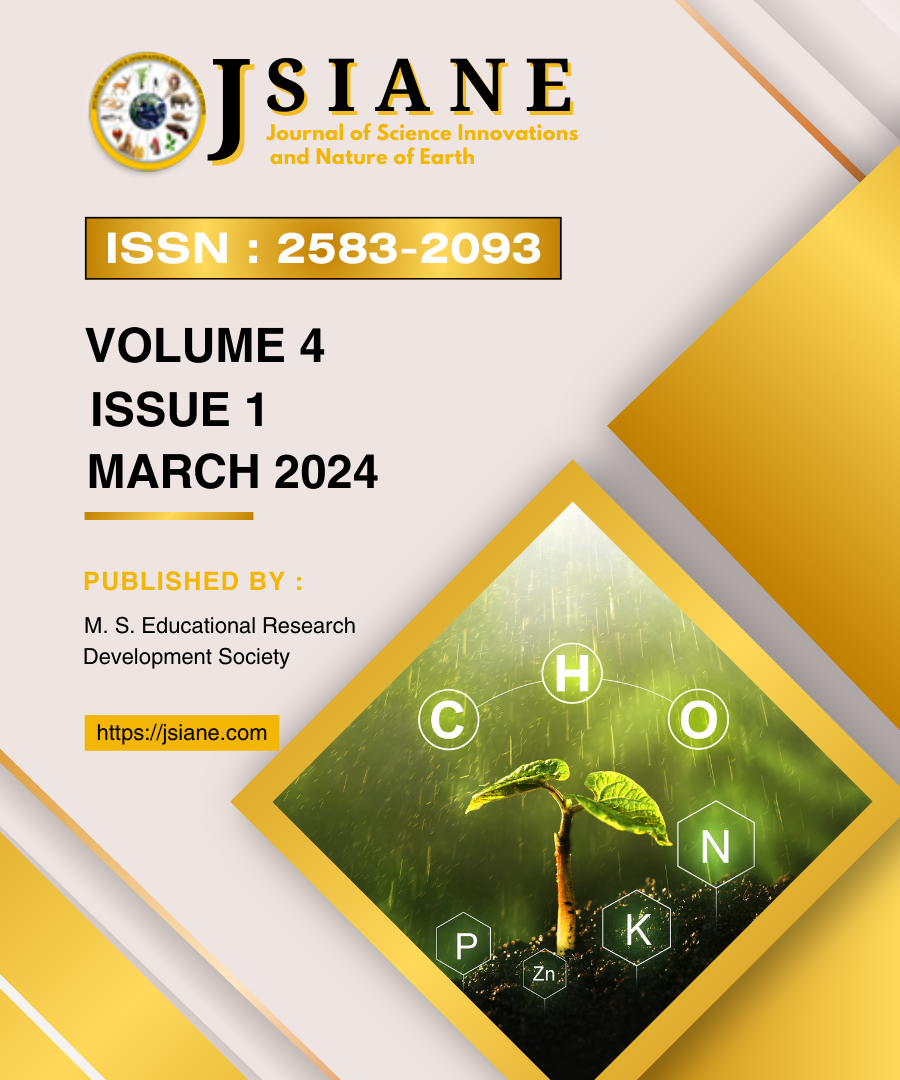Comparative Toxicity of Organic vs Synthetic Insecticides on Aquatic Ecosystems
DOI:
https://doi.org/10.59436/10.59436/jsiane395Keywords:
Organic insecticides, synthetic insecticides, aquatic toxicity, bioaccumulation, ecotoxicologyAbstract
This research paper investigates the differential impacts of organic and synthetic insecticides on aquatic ecosystems, focusing on toxicity, bioaccumulation, and long-term ecological effects. With increasing insecticide use in agriculture, aquatic environments are particularly vulnerable due to runoff and leaching. The study reviews and compares available toxicity data on commonly used synthetic insecticides such as chlorpyrifos and permethrin with organic alternatives like neem oil and pyrethrins. Results reveal that although organic insecticides are perceived as environmentally safer, they are not always benign. Synthetic insecticides tend to exhibit higher acute toxicity and persistence. The paper calls for integrated pest management strategies to mitigate aquatic toxicity.
References
Bradbury, S. P., & Coats, J. R. (1989). Comparative toxicology of the pyrethroid insecticides. Reviews of Environmental Contamination and Toxicology, 108, 133–177.
Casida, J. E., & Quistad, G. B. (1995). Pyrethrum flowers: production, chemistry, toxicology, and uses. Oxford University Press.
Ccanccapa, A., Masia, A., Navarro-Ortega, A., Pico, Y., & Barcelo, D. (2016). Pesticides in the Ebro River basin: occurrence and risk assessment. Science of the Total Environment, 540, 267–277.
Fleeger, J. W., Carman, K. R., & Nisbet, R. M. (2003). Indirect effects of contaminants in aquatic ecosystems. Science of the Total Environment, 317(1-3), 207–233.
Halstead, N. T., et al. (2015). Agrochemical pollution increases risk of human exposure to schistosome parasites. Environmental Health Perspectives, 123(8), 875–882.
Kumar, A., Sharma, B., & Pandey, R. S. (2012). Toxicological assessment of neem-based pesticide on aquatic model. Ecotoxicology, 21, 1869–1878.
Liess, M., & Beketov, M. A. (2011). Traits and stress: Keys to identify community effects of low levels of toxicants in test systems. Ecotoxicology, 20, 1328–1340.
Malaj, E., et al. (2014). Organic chemicals jeopardize the health of freshwater ecosystems on the continental scale. PNAS, 111(26), 9549–9554.
Regnault-Roger, C., Vincent, C., & Arnason, J. T. (2012). Essential oils in insect control: low-risk products in a high-stakes world. Annual Review of Entomology, 57, 405–424.
Rico, A., et al. (2010). Use of ecological models to assess effects of pesticides on aquatic communities. Ecotoxicology, 19, 581–602.
Rumschlag, S. L., et al. (2020). Consistent effects of pesticides on community structure and ecosystem function in freshwater systems. Nature Ecology & Evolution, 4, 912–920.
Schäfer, R. B., et al. (2011). Effects of pesticides on community structure and ecosystem functions in agricultural streams. Science of the Total Environment, 409, 5150–5158.
Schmutterer, H. (1990). Properties and potential of natural pesticides from the neem tree. Annual Review of Entomology, 35, 271–297.
Silva, E., Rajapakse, N., & Kortenkamp, A. (2019). Something from “nothing” – Eight weak estrogenic chemicals combined at concentrations below NOECs produce significant mixture effects. Environmental Science & Technology, 50, 10077–10087.
Stehle, S., & Schulz, R. (2015). Agricultural insecticides threaten surface waters at the global scale. PNAS, 112(18), 5750–5755.
USEPA (2017). Ecological Effects Test Guidelines. U.S. Environmental Protection Agency.
Beketov, M. A., Kefford, B. J., Schäfer, R. B., & Liess, M. (2013). Pesticides reduce regional biodiversity of stream invertebrates. PNAS, 110(27), 11039–11043.
Chagnon, M., Kreutzweiser, D., Mitchell, E. A., Morrissey, C. A., Noome, D. A., & Van der Sluijs, J. P. (2015). Risks of large-scale use of systemic insecticides to ecosystem functioning and services. Environmental Science and Pollution Research, 22(1), 119–134.
Cedergreen, N. (2014). Quantifying synergy: A systematic review of mixture toxicity studies within environmental toxicology. PLOS ONE, 9(5), e96580.
FAO. (2022). The State of the World's Land and Water Resources for Food and Agriculture – Systems at breaking point. Food and Agriculture Organization of the United Nations.
Holmstrup, M., Bindesbøl, A. M., Oostingh, G. J., Duschl, A., Scheil, V., Köhler, H. R., & Loureiro, S. (2010). Interactions between effects of environmental chemicals and natural stressors: A review. Science of the Total Environment, 408(18), 3746–3762.
Isman, M. B. (2020). Botanical insecticides in the twenty-first century—Fulfilling their promise? Annual Review of Entomology, 65, 233–249.
Kumar, S., Thomas, A., & Singh, R. (2018). Fate of pesticides in aquatic ecosystems and potential bioremediation techniques. Environmental Science and Pollution Research, 25(29), 28842–28850.
Liess, M., & Schulz, R. (2019). Linking insecticide contamination and aquatic ecosystem functions. Ecotoxicology, 28(4), 401–412.
Moore, M. T., Kröger, R., & Locke, M. A. (2018). Pesticides and their effects on the aquatic environment. Encyclopedia of the Anthropocene, 3, 187–193.
Mwanamwenge, J., Mutembei, H. M., & Nguta, J. M. (2019). Effects of pesticide residues on fish physiology: A review. Journal of Toxicology and Risk Assessment, 5(3), 1–9.
Regnault-Roger, C., Vincent, C., & Arnason, J. T. (2012). Essential oils in insect control: Low-risk products in a high-stakes world. Annual Review of Entomology, 57, 405–424.
Schäfer, R. B., Bundschuh, M., Rouch, D. A., Szöcs, E., Peter, C., Pettigrove, V., ... & Kefford, B. J. (2012). Effects of pesticides on community structure and ecosystem functions in agricultural streams. Science of the Total Environment, 416, 385–393.
Stehle, S., & Schulz, R. (2015). Agricultural insecticides threaten surface waters at the global scale. PNAS, 112(18), 5750–5755.
USEPA (United States Environmental Protection Agency). (2021). Aquatic Life Benchmarks and Ecotoxicity Summaries for Registered Pesticides.
Downloads
Published
Issue
Section
License
Copyright (c) 2024 Maharaj Singh Educational Research Development Society

This work is licensed under a Creative Commons Attribution-NonCommercial 4.0 International License.










